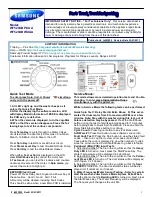
EN - 23
3. If there is lint accumulated on the
discharge cap in the tank, clean it with
water.
4.
Refit the water tank.
IMPORTANT:
Never remove the water
tank when the programme is running. The
water condensed in the water tank is not
suitable for human consumption.
IMPORTANT:
DO NOT FORGET TO
EMPTY THE WATER TANK AFTER EACH
USE.
6.3.
Cleaning the Heat Exchanger
IMPORTANT:
Clean the heat exchanger
when you see the warning “Heat Exchanger
cleaning”.
IMPORTANT:
EVEN IF THE “HEAT
EXCHANGER CLEANING WARNING
LED” IS NOT ON: CLEAN THE HEAT
EXCHANGER AFTER EVERY 30 DRYING
PROCESSES OR ONCE A MONTH.
1
2
3
4
5
6
7
If the drying process is completed, open the
loading door and wait for it to cool down.
1. Open the kick plate cover as shown.
2. Unlock the exchanger cover by turning
in the direction shown with arrows.
3. Take out the exchanger cover as shown.
4. Clean the front surface of the exchanger
as shown.
5. Fit the exchanger cover as shown.
6. Lock the exchanger cover by turning in
the direction shown with arrows.
7. Close the kick plate cover as shown.
WARNING:
DO NOT CLEAN
WITH BARE HANDS SINCE THE
EXCHANGER FINS ARE SHARP.
THEY MAY HURT YOUR HANDS
6.4.
Cleaning the Humidity Sensor
Inside the machine, there are humidity
sensors that detect whether the laundry is
dry or not.
To clean the sensors:
1. Open the loading door of the machine.
2. If the machine is still hot due to the drying
process, wait for it to cool down.
3. Using a soft cloth soaked in vinegar, wipe
the metal surfaces of the sensor and dry
them.
IMPORTANT:
CLEAN THE METAL
SURFACES OF THE SENSOR 4 TIMES A
YEAR.
IMPORTANT:
Do not use metal tools to
clean the metal surfaces of the sensor.














































